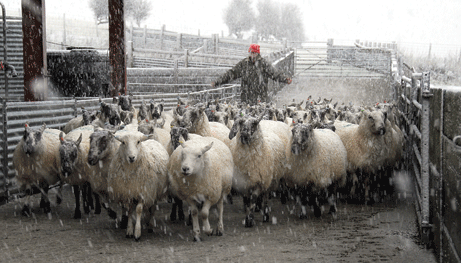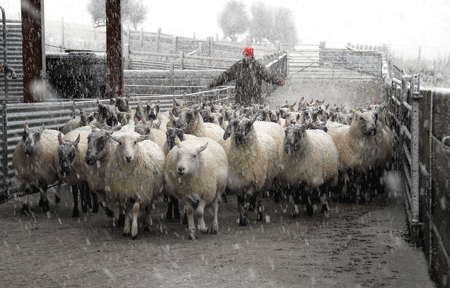Management Matters: Feed costs rise for Aled Jones

Sheep prices may have made a strong start to 2009, but a harsh winter at Tregeiriog Farm in Wales has seen feed costs rise as well.
Aled Jones was astonished and a bit envious when he saw prime lambs making over £80 a head during a recent visit to Oswestry Market. “We have to finish lambs before winter sets in so we could not really benefit from the rise in prices,” he says. “The last 37kg lambs we sent deadweight made £56.60.”
But Mr Jones did benefit from the early rise in prices when it came to marketing 280 store lambs. These went, for the fourth successive year, to the same buyer near Montgomery, where they are used to clean up pastures that carry high-yielding dairy cows in the spring.
The Beulah lambs averaged £38 a head and the Texel-cross and Mule tup lambs £41 a head. “Some were just about fit for slaughter, but we would have had to buy in every mouthful of feed to finish them all,” he says.

“I suppose they might have been worth £70 a head in January, but it is a case of balancing inputs, including feed, vet care, transport and commission, with the likely return. I think we are better off selling on the yard as stores to a man with whom we have built a good relationship.”
All the lambs were given their first injection, wormed and run through a formalin foot bath before sale so were unlikely to demand much attention during time spent on the dairy farm. “We were happy with prices that reflect the buyer’s confidence that the lambs would do well for him. The arrangement demonstrates the benefits of building good marketing contacts based on trust.”
Prices disappoint
But the pre-Christmas surge in prime lamb prices reminded Mr Jones that deadweight selling still has a long way to go to forge similar links between farmers and buyers.
As a member of an informal group of 25 lamb producers, which sold around 7000 lambs directly to an abattoir during the summer and early autumn, he was very disappointed by deadweight prices quoted in December and January. “Members still had possibly 2000 lambs to sell. When they saw the deadweight price they sent them to auction instead.”
The 256 ewe lambs sired by Texel rams carrying the Inverdale gene, which were produced on Tregeiriog Farm under contract to the breeding company Innovis, were collected in batches in September and October.
All but 50 reached the target weight of 40kg and realised the pre-set price of £48 a head. The value of the others was calculated on a sliding scale based on their collection day weights.
“The system suits us because we know in advance what price we will get if we achieve the target weight. Innovis owns the lambs, provides the tags, pays some veterinary costs and finds the buyers, so there are no marketing or transport costs.”
Once again 400 ewes will be put to Inverdale Texel rams in 2009. Leasing four ram lambs and two yearlings from the breeding company will cost the farm £700. “We also know that the male lambs will have good conformation and should make a decent price when we sell them,” Mr Jones says.
Ewes carrying the next crop of Inverdale Texel-sired lambs are being run as one of five groups used to manage areas of deferred grazing as efficiently as possible.
But, after just three frost-free nights between Boxing Day and 20 January, Mr Jones admits the quality of some grass leaves a lot to be desired. “Temperatures have dropped as low as minus 10 and we have had sleet and snow. Herbage has turned yellow, which has increased consumption of feed blocks.”
He hopes better weather will allow him to eke out the provisional 30t order. “We managed to get a discount for ordering early, but it would cost over £350/t to get extra supplies. Blocks work very well for us but they are each costing £2 more this year, which is a big increase for a low-cost system.
“We are fully committed to using deferred grazing but need to think about some sort of safety net for a harsh winter. We are considering using a local contractor to sow perhaps 30 acres of frost-resistant root crops.”
Lambing preparations
Ewes are looking very fit despite the lower than anticipated grass quality and should scan well over the next week, says Mr Jones.
Ewes lamb outside, but the farm’s big shed is being prepared to act as a “hospital” for sheep needing special care. The 15 big square bales of hay purchased from a neighbour for £20 each, and a small quantity of bedding straw, has been stacked in the main passageway.
Once again a retired farmer will take care of housed sheep, but Mr Jones’ young casual worker who has helped lamb the main flock for the last four years has left and a new assistant needs to be found.
The farm’s first class handling facilities were invaluable when giving all the ewes a vital pre-lambing copper injection costing 25p/head, and for treating ewe lambs that were not thriving. “The problem started in mid-August so we had them blood tested, did a faecal egg count and checked for liver fluke,” says Mr Jones.
Results did not point to specific problems so the young ewes were dosed with multi-minerals and vitamins. This improved their vitality, but they still have a lot of growing to do in the spring.
The farm does not run cattle, but Mr Jones and his partner, Jane, have started their own pedigree Welsh Black herd on his father’s farm. Four in-calf heifers were bought for £950 a head and a maiden heifer for £1100. The aim is to build the herd to about 25 cows. “I feel there is a great future for our native breeds and there could be financial inducements to keep them in the hills.”
More information on Tregeiriog Farm
More information on other Management Matters farms
